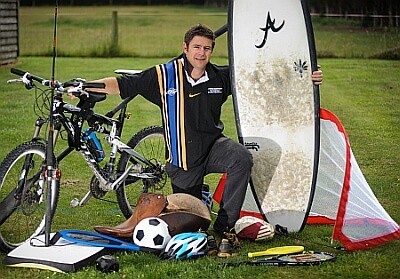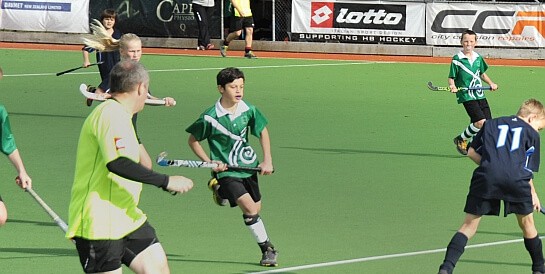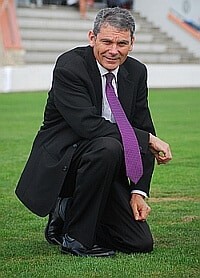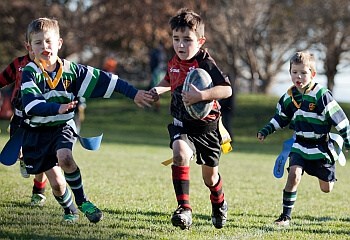Sport is more than fun, fitness and games … in Hawke’s Bay it’s a potential economic powerhouse, as Keith Newman reports.
Sport has not to date been a frontrunner in Hawke’s Bay’s economic stakes. However, there’s a growing view that a proactive regional strategy could more than double annual earnings to around $40 million in 2014.
While tourism and its wine, food and art deco allies get the highest profile, a proud sporting heritage which attracts large crowds and has ample capacity for more lucrative drawcard games, remains on the sideline.

A decade ago, attempts to get local councils on the same team with a regional sports strategy failed miserably when interest flagged and the invisible attitude barrier between cities went up.
Now, a high-level team of determined civic and sports leaders is preparing a fresh game plan by pitching Hawke’s Bay as a first-choice location for national and regional games and international fixtures.
Sport Hawke’s Bay (Sport HB) and the Hawke’s Bay Sports Council are both refining long-term strategies, informed for the first time by thorough market research.
Sport HB chief executive Colin Stone, says one of the challenges has been the lack of a regional bid fund to underwrite events. “It’s always been a major hurdle when coming up against Taupō, Taranaki or Palmerston North who are more proactive.”
He reckons a half-million dollar pool from councils and businesses should do the job, but first the region must build a compelling case for the economic pulling power of the region’s combined sport-related assets and resources.
“If we are going to be serious about attracting events we have to offer far more than our fantastic Mediterranean climate, and saying ‘the doors are open, come and enjoy the sunshine’.”
Rick Barker, former Labour MP and now HBRC councillor, says he’s never understood why the Bay doesn’t make better use of its facilities and assets by hosting more national and international sports tournaments and events.
Barker, who’s the Regional Council’s representative on the Sports Council, claims the region has often shown a “lack of vision and initiative”, and suggests amalgamation may end the parochial stand-offs which prevent Napier and Hastings making unified bids for events.
“When the Olympics were held in Sydney a number of teams came to New Zealand to do their preparation … Hawke’s Bay had the ideal environment and climate. It was a huge opportunity and we missed it.”
Damon Harvey, new board chairman of Sport Hawke’s Bay and a trustee with Team Hawke’s Bay Trust (Team HB), is frustrated at the limited support for the Trust’s ‘Come on the Bay!’ brand at various council sport venues.
Team HB’s mandate is to fly the flag for sport in Hawke’s Bay, provide branding materials to the various codes and helping get ‘more bums on seats’ at the major games.
Despite forging an alliance between the Hawke’s Basketball Team, HB United Football, Sport HB and the Magpies, it struggles to maximise the impact of that partnership without council support.
While there’s firm evidence that sport events bring national and international profile and financial windfalls for local businesses, especially hospitality and accommodation, he says, this hasn’t translated to any sustainable funding.
Sport HB’s Colin Stone is hopeful the latest economic data will be a game changer. Numbers crunched by local economist Sean Bevin show the combined revenue generated from 19 Hawke’s Bay sports events over a 24 month period was $47 million.
After imported goods and services and promotor’s bills were deducted, that netted $21.75 million to the GDP of the region, a number Stone reckons could be doubled over the next year, “if we all put our minds to it and paddle the waka in the right direction”.
Stone says the 2011-2012 numbers were achieved without a coordinated plan, a regional strategy or a bid fund to help win events. “I bet the moteliers of Hawke’s Bay would be at a loose end if it wasn’t for sport.”
Stone says there are a number of regional level facilities that can be used to drive events into Hawke’s Bay, including the Regional Sports Park, the A&P stadium and showgrounds, Pettigrew Green Arena, Nelson Park, Park Island and McLean Park in Napier.
Flagging interest revived
Sport HB first began working on a Regional Sport and Active Recreation Strategy in 2003 when all five local councils agreed that shared resources and economies of scale sounded good. After launch, however, the follow-through just wasn’t there.
“They [councils] lost ownership so it became a Sport HB strategy, and then by default it was referred to as Colin’s strategy, which was a nightmare for me,” says Stone.
Since then Sport HB has been back around the table with Sport NZ, its primary government funder, developing a more accurate data model to describe the sector, including an inventory of all the codes, active participants, facilities, and the social and economic impact.
Sport HB, is tasked with facilitating growth by building sector capability, supporting school sport and promoting physical activity among those at risk. It barely escaped financial difficulties this past year, and as a charitable trust has several masters it must answer to: Sport NZ, the five Hawke’s Bay councils and the health sector.
From July 2014, a new four-year plan comes in play, including championing the region as the ‘go to’ place for sport events. Pivotal to ensuring local authorities have “far more skin in the game” is the involvement of the Regional Sports Council, chaired by Stone.
The Sports Council, now developing a 10-year ‘regional sports strategy’, comprises senior officers and politicians from all five councils, the heads of regional sports bodies and representatives from Pettigrew Green Arena and the Regional Sports Park, the key non-council-owned facilities.
A regional facilities ‘blueprint’, cataloguing every sporting venue and identifying any glaring gaps, opportunities or obstacles, is expected in March.
“Despite the challenging political environment we have made good progress and come through with a unified and progressive stance which is heading in the right direction,” says Stone.
Bastion with bright future
Napier City Council sports facilities administrator Andrew White describes Hawke’s Bay as being “a bastion of sport” and the Sports Council as the “biggest melting pot for regional sports ideas”.
He says people flock to major events and local weekend games. “A lot of people play sport; a lot of people play a lot of sport; a lot of people watch sport … Just go to Park Island on a Saturday morning to watch junior sport or in the afternoon the place is just jam packed with cars.”

White is involved in preparations for the Cricket World Cup in 2015 at McLean Park with teams training at Nelson Park. “It’s a big event that will really expose Napier to the world with a billion people expected to watch the game on TV.”
Hastings City councillor and sports advocate Wayne Bradshaw says he’d like to see overall management and planning of sports in Hawke’s Bay “done better”. Despite the achievement of the Hawke’s Bay Sports Park, he says his own council has been slow to deliver an updated sports and recreation strategy.
One of the principals behind the Sports Park was no cannibalisation. “I’d like to see a snapshot that shows whether we are growing sport or just moving it around.” While Hastings has significant number of sports fields, one of the reasons soccer found a place at the Sports Park was to free up the shoulder season for softball at Akina Park.
Meanwhile Sport HB has forged an alliance with Tourism Hawke’s Bay as part of the Regional Events Strategy to ensure sport is right up there with all other events’ planning and promotion.
Damon Harvey points to the examples of Wellington’s hosting of AFL games and Auckland’s hosting of the newly created NRL Nines event in February. “Perhaps Hawke’s Bay could adopt a team in the NRL and they play one of their games here.”
HBRC councillor Rick Barker proposes building the reputation of other codes to the high level of one-day cricket. “Sport and tourism go hand-in-hand; they both promote Hawke’s Bay and there’s a great synergy.”
He points to the P-class national yachting championships that attracted many people from Auckland to Ahuriri in 2011. “Many had never been to Hawke’s Bay; they went home with baskets of fruit and bottles of wine and many came back. The Mission Concert appeals to a certain segment, but sport appeals to a much wider range.”
Crunching the numbers
A 2011 Lincoln University-Sport NZ survey proved a wake-up call when it revealed sport made a $5.2 billion contribution to our national GDP.
Additional health benefits and productivity gains allegedly added a billion dollars; and the benefits of participating or being a volunteer, brought the estimated overall value to $12.2 billion.
Sport NZ estimated over 90% of young people and adults in Hawke’s Bay engaged in at least one sport or recreational activity annually. Around 33,000 people volunteered across various sports and according to data for the 2008-2009 year, the overall contribution to the regional GDP was $179.6 million or 2.8%.
At the time Sport HB reckoned this was a little low, as it didn’t take into account the direct economic benefit of sports visitor spending in Hawke’s Bay, which it thought might be around $40 million gross.
Now armed with data that proves its economic assumptions, Sport HB is awaiting results from its facilities inventory, trends and participation research to give it a better understanding of the issues ahead for schools, regional sports organisations and community groups.
With the right data under its belt it will be able to build a watertight business case for local government and the codes to make a more concerted effort to think, act, invest and promote regionally.
“The challenge will be to match the top-down expectations from the Government and the bottom-up expectations of the community, which don’t always align,” says Stone.
Bid fund proposed
The facilities inventory will include identifying any barriers to winning events to the region. While McLean Park is “massively underutilised” and the only suitable venue for some major sports, Team HB trustee Damon Harvey claims conditions can be prohibitive and the venue needs to be more marketable.
Its branding arm, Come on the Bay, used the Phoenix Football Club from Wellington versus the Newcastle Jets at McLean Park on Labour weekend as a test case to scope out the risk in running a drawcard event.
Neither Central Football nor HB United wanted to take it on and local councils showed no interest, so Team HB went cap in hand to ten local businesses to underwrite the deal with the support of Sport HB.
Negotiations with Napier City Council (NCC) however proved difficult. Rather than being charged a flat fee of say $20,000, Harvey says “everything asked for had a cost and there was a multiplying effect with little flexibility,” including getting signage on the field.
The Phoenix game was telecast throughout Australia and parts of the UK and Asia, but there wasn’t even a welcome to Hawke’s Bay or Napier sign on field. “A great opportunity to showcase the region was lost,” he says.
“It was a beautiful spring day, the weather was magic, the sun was shining on the stand, the place was nearly packed with 9,000 people but it was a huge risk,” says Harvey.
The exercise and the game ended with no winners. While the trust just broke even, Harvey says it shouldn’t have been about that. “It should have been a success with something left in the kitty to enable the next event.”
His sense was that any promoter would be likely to think twice about using that facility again.
NCC’s Andrew White insists a lot of negotiating went into the contract.
While aware some cities “do more” to attract sports tournaments and games including putting up money, he insists Napier will subsidise ground charges, although he’s unsure whether that’s at the level of other regions.
Sport HB’s Colin Stone says local businesses put themselves on the line to ensure the Phoenix game and the forthcoming international hockey events at the Sports Park got the go-ahead. “There was nothing in it for them, it was purely goodwill.”
Stone’s vision is that local authorities and corporate Hawke’s Bay create a regional fund of about half a million dollars to “proactively and aggressively” win multiple events. “That way we could be working on events all the time; some might take a hit others might add to the pot. It would be an incentive to get them here.”
While running regional events has been made “incredible difficult” through twin city politicking, Stone is confident there’s a “refreshing” wind change.
“Wayne Jack, the new CEO at Napier City has been fantastic to deal with. He gets it and I think there’s a real opportunity to work proactively, which hasn’t been a priority before.”
Rick Barker says under amalgamation it won’t be Napier’s McLean Park or Hastings facilities, it’ll be Hawke’s Bay’s facilities. “With a regional strategy we could do a whole lot better in this space.”
Shaped by shifting trends
The traditional codes – rugby, rugby league and cricket – are holding their own with strong club loyalty, while netball remains the most popular, and football and hockey are experiencing steady growth, as are a range of customised sports.
The growth in people playing hockey, particularly from Hastings and Central Hawke’s Bay, puts the squeeze on the two turfs at Park Island; the average is about 850 people per turf but Hawke’s Bay is around 2,500.
That pressed the right buttons for the development of the new Unison Hockey Stadium currently under construction at the Hawke’s Bay Regional Sports Park in Hastings, ahead of the first inter-national women’s hockey tournament games in April.
Swimming is another area of attention. While remedial work is underway across a number of public swimming pools, the emerging view is that existing facilities are neither luxurious nor adequate and there’s a need for a regional facility. If that’s proven, a decision needs to be made on location and whether to build a 30 metre or 50 metre pool, or one with a hydraslide.
Napier City Council is trying to accommodate the overlapping of winter and summer sports codes which came to light in its refreshed 2012 Activity Management Plan for sportsgrounds.
Much of the crossover is created by longer football seasons, making it difficult to prepare the grounds for other codes during the traditional crossover period.
Sports facilitator Andrew White says this is partly to do with “changes in the design of sports”, where more versatility and opportunity is built in so people around the fringes have more opportunity to participate.
That also requires flexibility in the way sports grounds and facilities are designed to cope with unexpected growth or changing needs of codes. “If we had no ability to provide extra space, then we would be severely challenged,” says White.
Sharing of facilities is also a growing trend that’s being encouraged. At Park Island different sports codes – football, rugby, softball – co-exist using the same club rooms. “It’s proven to be a much more sustainable model for sport organisations, rather than clubs building independent facilities,” says White.
Flexible sporting fix
Sport HB’s Stone says time pressure, working longer hours, transport and cost issues have created a demand for a more flexible sporting fix through “non-conventional or abbreviated” experiences.
Rather than having to turn up on a Saturday or Sunday morning or afternoon, sports codes are developing new products and services including ‘pay to play’ and one-off sports better suited to the ‘time-poor’.
Twenty-20 cricket, futsal (indoor football), fast netball, 3-on-3 basketball and sports that cut down the number of people in a team and the time needed to participate are in demand.
There’s been a significant rise in those participating in duathlons and triathlons, where, as Stone puts it, “people can train at their leisure, pay their $20 to enter and then go home after they’ve won their spot prize.”
This might include the Triple Peaks and the Cape Kidnappers Challenge, where about 800 competitors train and then perhaps do another two events during the year. Iron Māori, for example, a locally-created event, has become so popular it’s now held around the country and in Australia.
Stone maintains sport is still cheap entertainment despite the moaning about club or pay-to-play fees. He shares the anecdote of two squash players complaining over the $6 cost of a game of squash, then going up to the club rooms afterwards to continue grumbling over an $8 beer.
He suggests society has become used to sport offered by volunteers at limited cost, while demanding a higher quality offering they’re not prepared to pay for. “Hawke’s Bay is one of the worst regions, we’re a bunch of tight arses.”
He says that’s particularly true of junior sport, where the grumbling is about transport, affiliation costs and membership fees.
A less quantifiable activity is the return to the playground for many young people who simply organise themselves to get down to a local park for a game of touch or just to toss a ball around. Perhaps this includes many of the 15-18 year olds who annually drop out of organised sports.
Local economist Sean Bevin says events are happening across Hawke’s Bay all the time: “We’re right up there in terms of sports participation and involvement” and have everything needed to host larger events.
Bevin, who’s involved with the Napier City Rovers, says the annual under-19 Labour Weekend tournament, for example, attracts about 50 teams from across the country. “That’s a lot of people coming into the Napier-Hastings area.”
If we’re planning to put out the invitation to escalate the hosting of larger events, he suggests we also need to gear up our tourism, accommodations and facilities, and make certain that the right technology is in place.
“You have to meet modern-day needs with internet, and everything TV and media agencies want to plug into for 21st century communications. We can’t afford to be ad hoc about things.”
Before the new regional approach has even begun to flesh out the hopes and dreams of a new era of cooperation, the sporting calendar for 2014 is already looking vibrant.
There’s the Black Caps one-day cricket on January 19; Horse of the Year in March, which typically brings in $12 million; the women’s international hockey tournament starting in April; the National Indoor Bowls Championships at Pettigrew Green Arena in June; and for the first time since the 1990s, the All Blacks will play a test match at McLean Park on 6 September.






